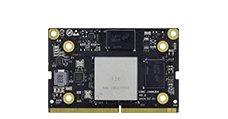CAN Usage¶
Introduction to CAN¶
CAN (Controller Area Network) bus, also known as the Controller Area Network bus, is a serial communication network that effectively supports distributed control or real-time control. The CAN bus is a widely adopted bus protocol in automobiles, designed for microcontroller communication in automotive environments. For more information, you can refer toCAN Application Report
Hardware Connection¶
CAN on AIO-1688JD4 Development Board The interface location is shown in the figure
Since there is only one CAN, it is set by default in the kernel that the first created device is can0。
CAN Communication Testing¶
Use the candump and cansend tools for message transmission and reception testing. Place the tools in the /system/bin/ directory to execute. The tools are included in the SDK, and can also be found at Official Or github Download.
#Disable the can0 device on the transmitter and receiver side
ip link set can0 down
#Set bitrate to 250Kbps on both the transmitter and receiver sides.
ip link set can0 type can bitrate 250000
#Turn on the can0 device on both the transmitter and receiver side.
ip link set can0 up
#Execute candump on the receiving end, block and wait for the message.
candump can0
#Execute cansend on the sender side, send the message.
cansend can0 123#1122334455667788
More commands¶
1. ip link set canX down //turn off the can device;
2. ip link set canX up //turn on the can device;
3. ip -details link show canX //show canX device details;
4. candump canX //Receive data from the can bus;
5. ifconfig canX down //Disable the canX device for configuration.
6. ip link set canX up type can bitrate 250000 //set can baud rate
7. conconfig canX bitrate + baud rate;
8. canconfig canX start //start the can device;
9. canconfig canX ctrlmode loopback on //loopback test;
10. canconfig canX restart // Restart the can device;
11. canconfig canX stop // stop the can device;
12. canecho canX //View can device bus status;
13. cansend canX --identifier=ID+data //send data;
14. candump canX --filter=ID:mask //use filter to receive data with matching IDs
